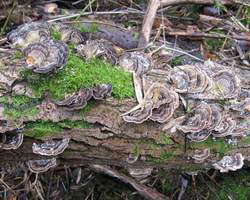Abandoned Communities ..... Y Graig
The Tithe records show that Christopher Williams and his family occupied three small areas of land, just over two acres altogether (plots 902, 903, and 904). Sue Smith has used census data and parish records to give an outline of what happened to the family over the next sixty years. In 1841 Christopher and Eliza Williams had a daughter, also Eliza. A servant, Emely Watkins, lived with them. Christopher worked as an agricultural labourer and later as a wood cutter. Over the following 20 years Emely Watkins departed, but four more children were born, Caroline, Mary, John, and Edwin. By 1871 Christopher had died, but Eliza was still working as a market gardener. By 1881 all Eliza Williams' children had left home, but the younger Eliza, now Eliza Follett, had been married and widowed and had returned to live with her mother. The older Eliza still worked as a farmer, but her daughter had no occupation. Eliza Williams died before 1891, when Eliza Follett occupied the property as a farmer and had a niece, Edith, living with her. The 1911 census indicates that Eliza Follett, then aged 71, was still living there, together with Edith, a nephew Samuel Lewis aged 51, and four children.
Sue Smith, Y Graig -
The village continued to be occupied well into the twentieth century, and even today about three houses remain on the southern edge of the hillside. Sue Smith's research has revealed that about 40 families are represented in the records of the local parish, Llanwenarth Citra, between 1900 and 1947, and about 30 people were recorded on the electoral registers for 1918, 1928, and 1938. More research is needed to clarify exactly where they lived, and the reasons why they finally decided to leave.
A good time to visit Y Graig today is during the winter. There is less vegetation, making it easier to see things and to find your way around the site. Even then, however, you will come across fallen trees and branches and will be called upon to decide whether to climb over them, duck under, or make a detour. An added bonus during the colder months is the profusion of varieties of fungus growing out of rotting pieces of wood. In the areas where the main groups of houses are located the task of exploration has been made easier since a contingent of Gloucestershire boy scouts carried out a major clearance operation in the summer of 2006.
It is possible to gain access to Y Graig in several ways. The most convenient, however, is to begin in the central area. Travelling along the A40 from Abergavenny you pass a lay-by on the right hand side and then make a very sharp right turn up a narrow road that has probably not changed much since 1842.
If you are coming by car and notice other traffic on your tail you may consider it prudent to continue past the turning and make a U-turn at a Peugeot dealer a few hundred yards further on.
Four
Track leading to the western end of the settlement
House PRN 5851, near the western end
One of the many types of fungus on display at Y Graig, Trametes Versicolor otherwise known as Turkey Tail


